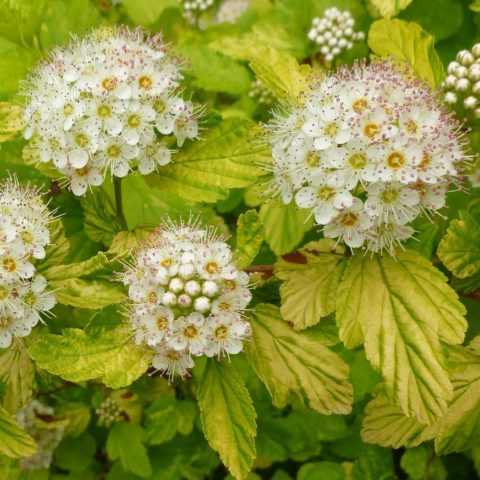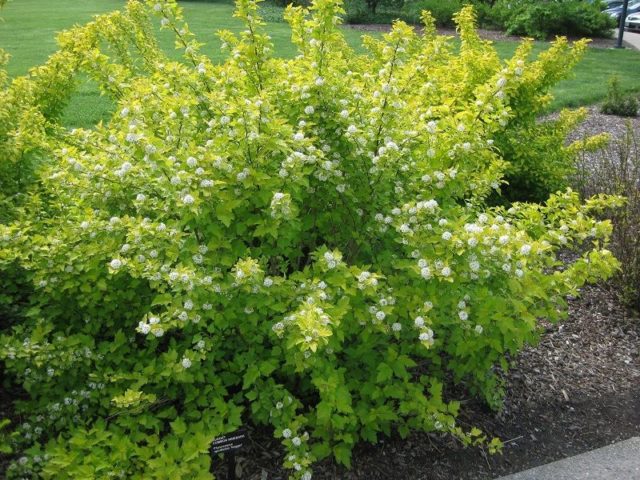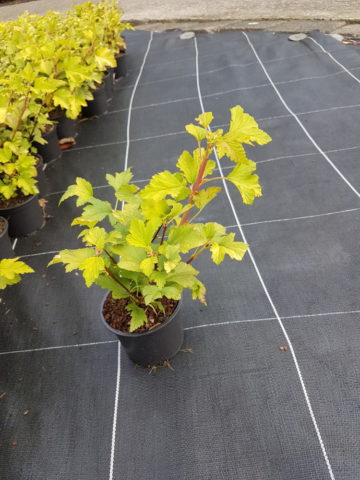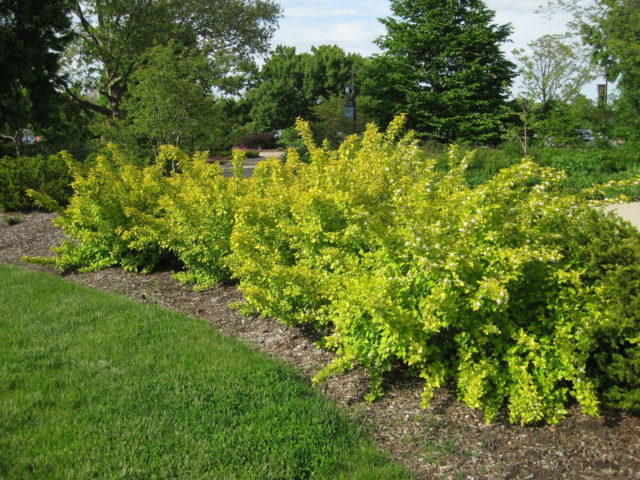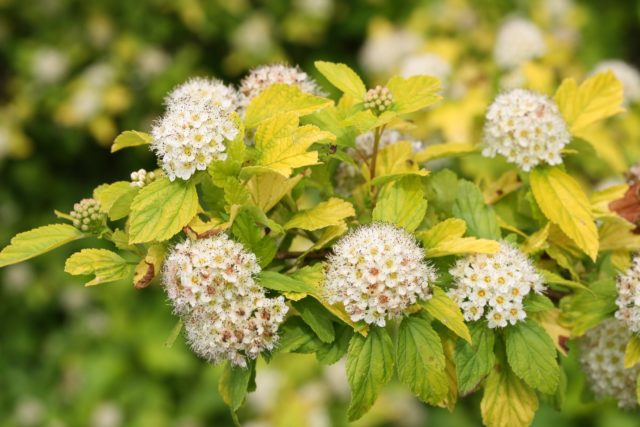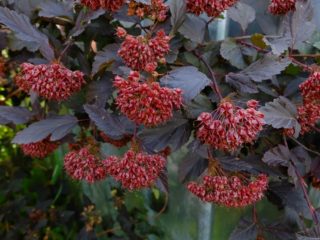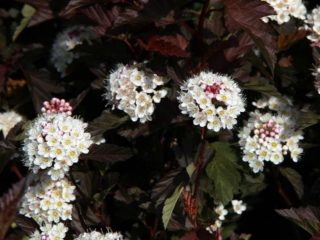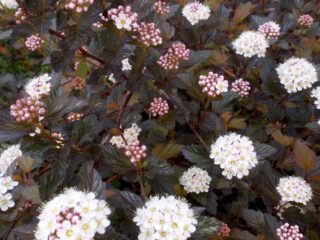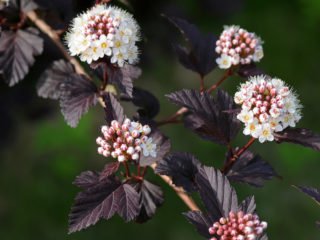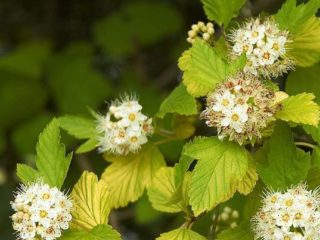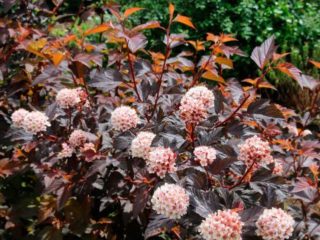Content
Nugget (or Nugget) is an unusually beautiful, hardy and low-maintenance shrub. The plant is often used in landscape design because, thanks to the bright color of the foliage, it can add zest to any composition.
Description of the Nugget bladderwort
The main advantage of Golden Nugget is its lush foliage, which changes color throughout the season. In early spring, the leaves are usually pure yellow; in the summer they take on a lemon green hue, and in the fall the foliage color changes back to a deep yellow. The leaves themselves are large, corrugated, and have serrated-toothed edges.
The viburnum-leaved vesicle carp Nugget blooms for about three weeks. Flowering usually begins in mid-June. During this period, multiple snow-white or pinkish-white small flowers, collected in corymbose inflorescences, appear on the shoots of the bush. The flowers become especially decorative due to their red fluffy stamens.Towards the end of summer, re-blooming is possible. In the fall, after the bladderwort bushes have finished flowering, the formation of swollen reddish fruits begins.
As you can see from the photo, the spreading, drooping branches of the Nugget vesicle form a lush spherical crown. On old shoots the bark peels off. The height of the bush is about 2 - 2.5 m. The plant lives for about 40 years.
Nugget bladderwort in landscape design
Thanks to its unusual bright yellow color, the Nugget viburnum leaves looks impressive even when planted alone against the backdrop of a lush lawn or evergreens. This shrub can complement any flower arrangements.
When forming a hedge from the viburnum-leaved vesicle Nugget, you can get a bright and original result. The combination of various viburnum-leaved vesicles with each other also looks interesting. So, for the lemon-yellow Nugget variety, ideal companions would be varieties with purple-violet leaves, for example, Little Devil or Summer Vine.
Conditions for growing viburnum leaf vesicle Nugget
You can grow Nugget viburnum leaf carp in almost any area, but the plant exhibits its full decorative properties only in open, sunny areas. In shade and partial shade, the leaves take on a normal green tint.
The shrub is undemanding in terms of soil composition, but it does not develop well in soil with a high lime content. Overmoistening of the soil is detrimental to the plant. The Nugget variety is highly resistant to drought and low temperatures.
Planting and caring for Nugget bladderwort
The viburnum-leaved bladdercarp Nugget is a plant that even the most inexperienced gardener can plant. Caring for the shrub is quite simple; it needs to be watered regularly, periodically fed, pruned twice a season, loosened the soil in the tree trunk circle as necessary, and removed emerging weeds.
Preparing the landing site
In order for the crown of the plant to be lush, the soil must be loamy, loose and fertile. Soil mixture for viburnum nugget can be prepared by mixing:
- garden soil;
- peat;
- sand;
- turf.
The optimal size and depth of the planting hole is about 50 cm. The hole must be drained and lined with humus or peat. Then part of the fertile soil mixture should be placed in it in advance (about half a month before planting) so that it has time to settle.
Landing rules
Seedlings with a closed root system have a better survival rate; they can be planted not only in the fall, but also in the spring, and the likelihood of damaging the roots during transplantation is minimal.
Algorithm for planting viburnum-leaved vesicle carp Nugget:
- carefully remove the seedling from the container;
- immerse in the planting hole along with a lump of earth;
- sprinkle with the remaining fertile soil mixture, deepening the neck by 5 cm to activate dormant buds;
- pour generously with water, mixed with Kornevin if desired;
- mulch with a layer of peat or humus.
Watering and fertilizing
Watering should be regular and abundant, but the soil should not be over-moistened.
To ensure intensive growth and development of the viburnum leaf vesicle Nugget, it must be fed periodically. An ideal nutrient solution containing:
- 10 liters of water;
- 1 kg mullein (can be replaced with 10 g urea).
Trimming
In its natural form, the Nugget viburnum leaf carp has a compact spherical crown, but with the help of pruning it can be given any desired shape. The bush responds very well to pruning, after which the crown thickens and becomes more lush.
Sanitary pruning of the viburnum-leaved vesicle Nugget is carried out in spring and autumn. At this time, remove all damaged, dried and diseased shoots. Formative pruning is carried out in order to give the bush some shape. To maintain the natural shape of the bush, the shoots are pruned at a height of approximately 1.5 m, removing all thin branches.
Preparing for winter
Since the viburnum-leaved vesicle Nugget is highly resistant to low temperatures, it requires preparation for winter only in regions with a harsh climate. To do this, it is enough to mulch the soil in the root zone. If the tops of the shoots freeze, they will quickly recover with the arrival of spring.
Propagation of Nugget bladderwort
Like all viburnum-leaved varieties, Nugget bladderwort is propagated in several ways: cuttings, layering and dividing the bush. Growing from seeds is practically not practiced, since in this case the varietal qualities of the plants are poorly preserved, and there is a high probability of getting green foliage instead of the expected lemon-yellow color.
Most often, the viburnum-leaved vesicle Nugget is propagated by cuttings, since the rooting rate reaches almost 100%. Cuttings are taken from bushes at the age of 5 - 10 years. The optimal time for cuttings is mid-June, early August. The length of the cuttings should be approximately 10 cm; half the length of the leaves is removed.
Coarse river sand mixed with peat in a 1:1 ratio is used as a rooting substrate. The cuttings are planted in the substrate at an angle, deepening by 2 - 3 cm. Transplantation to a permanent place is carried out next spring.
The viburnum-leaved vesicle carp Nugget can be propagated by dividing the bush in autumn or spring. To do this, the bush needs to be dug up along with a lump of earth and, using pruners, carefully divided into parts that have at least two shoots and a good root system.
Reproduction by layering is carried out in early spring. Only strong, healthy branches are used as layering. The shoots, with the exception of the tops, are cleared of leaves, placed in holes up to 15 cm deep and pinned to the ground with wooden staples. At the end of autumn, the cuttings are separated and covered for the winter.
Diseases and pests
Pests and diseases rarely attack the viburnum leaf Nugget. However, sometimes, due to a lack of nutrients, a shrub can develop late blight: in this case, young foliage begins to turn yellow, and the shoots gradually dry out.
Spraying the leaves or watering the plant at the root with a solution of iron chelate, Antichlorosis or Ferovit will help cure the disease.
Conclusion
Nugget viburnum is an unusual plant that is becoming increasingly popular among gardeners and landscape designers.The shrub is undemanding in terms of soil composition and care, resistant to low temperatures and most pests and diseases.
